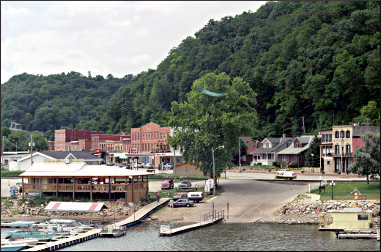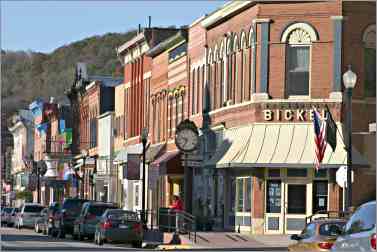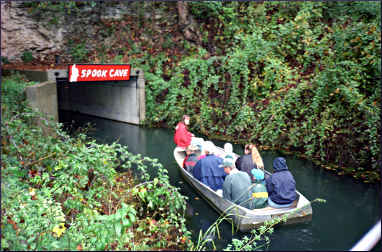Memorable McGregor
A picturesque river town in Iowa claims more than its share of characters.

© Beth Gauper
Over the years, the byways around McGregor, Iowa, have seen an extraordinary procession of people.
Between 650 and 1300, Woodland Indians built animal-shaped burial mounds, 29 of which are preserved nearby at Effigy Mounds National Monument.
In 1673, Father Jacques Marquette and Louis Joliet arrived via the Wisconsin River, claiming the land for France and paving the way for the fur trade, whose center was just across the river in Prairie du Chien.
Lt. Zebulon Pike paddled through in 1805, choosing a site on the 500-foot bluffs south of town for a fort, though it was built instead on the prairie across the river.
In 1837, Scotsman Alexander MacGregor started running a ferry across the Mississippi. The new port of McGregor boomed during the Civil War, and the streets became clogged by wagons full of grain from the wheat fields to the west.
There was other river traffic, too. The young sons of harnessmaker August Ringling saw their first circus performance when a showboat drew up to McGregor's docks.
But railroads eclipsed the river, and McGregor faded. Until, that is, the tourists came. Today, it's tourists who clog the streets, especially on fall weekends.
This corner of Iowa is perhaps the most beautiful stretch of the Mississippi, with its rounded bluffs framing a jumble of islands and sloughs.
The two state parks atop the bluffs just south of McGregor have the river's most spectacular views: Pikes Peak, with 12 miles of hiking and skiing trails, and Wyalusing, across the river in Wisconsin, with 20.
McGregor itself is tucked away in a little bowl, hugged on three sides by wooded bluffs.
There's no way to get there that's not relentlessly scenic: by way of Decorah and bluff country from the west; along the River Road and Lansing from the north; along the Wisconsin River Valley and Prairie du Chien from the east; and via Dubuque and Guttenberg from the south.

© Beth Gauper
One fall, I drove in from the west and stopped seven miles out of town at Spook Cave, at the base of a bluff along Bloody Run Creek.
There, I piled into an old aluminum fishing boat with seven other people and our teen-age guide, Randee, who explained that locals named the cave for the hollow sound of water splashing over rock.
Then we glided into an opening, dynamited in 1953, and squeezed under a low ceiling and through a passage.
"We call this Lovers Lane, because you either learn to love the person next to you or the wall," Randee said.
At first, we saw little besides broken-off stalagmites cemented around a "wishing well." Then we entered Formation Alley, with its glossy Frozen Waterfall, soda straws and ribbon stalactites, with one pearly white set called "Jaws" that did look just like a row of incisors.
Randee pointed out two bats, confirmed by shrieks from the boat behind us, and pointed out the wooden shaft overhead where enterpreneur Gerald Mielke brought in a tractor to clear out mud and rocks.
Farther down U.S. 18, halfway down the hill to McGregor, I found another unusual attraction. It was Daniel Slaughter's yard, part of a business called Wood Crafts & Junk, but also a folk-art extravaganza.
There was a quarter-ton painted Elvis carved from a tree trunk. There was Pancho Villa, Uncle Sam, King Tut, Frankenstein, Paul Bunyan and a giant nutcracker. And there were all kinds of gewgaws, stuck here and there — bowling pins, license plates, carousel horses, antique gas pumps.
Along Main Street, I stopped at the Historical Museum, which houses an even more peculiar sight — sand "paintings" inside bottles.
Andrew Clemens was a local deaf man who, using 45 shades of sand he scraped from the walls of a cave in Pikes Peak State Park, executed impossibly intricate portrayals of Victorian houses, locomotive engines, even George Washington on a horse.

© Beth Gauper
By the time Clemens died in 1894, at the age of 37, he was known among high society around the world.
The slender hickory sticks he used to arrange the sand are displayed in the museum, along with a bottle with a floral bouquet and the legend "Merry Christmas 1891," written in a flowing script of black sand.
There's another attraction down the street, at River Junction Trade Co., a shop that may as well be a museum.
Catering to re-enactors, theme-park actors and anyone else who needs an outfit from the years 1870-1900 — "the cowboy, the gunfighter and the riverboat gambler," says owner Jim Boeke — River Junction carries lace snoods, drover's shirts, ostrich-feather fans, carpetbags, period pistols, sheriff's badges and a lot more.
Somehow, over the years, McGregor became a cradle for people with unusual visions. Its bread and butter today, however, is sightseeing and shopping.
Most of the antiques in northeast Iowa seem to have found their way to McGregor's shops, and two weekends of craft festivals draw even more shoppers.
And now a new breed of tourist is coming for the hiking, canoeing and bird-watching at Effigy Mounds and in Yellow River State Forest. It's a beautiful part of the state — and definitely not flat.
Trip Tips: McGregor, Iowa
Getting there: It's across the Mississippi River from Prairie du Chien, Wis.
Events : June-October, monthly Hole in the Sock Gang street theater with bank robberies, cowboy shootouts and saloon girls, sponsored by River Junction. July and October, Arts & Crafts Festival.
Events nearby: June, Lazy River Beer & Wine Festival in Marquette. September, Germanfest in Guttenberg.

© Beth Gauper
Accommodations: On Main Street, Little Switzerland Inn rents suites, a room and an 1848 log cabin.
Up the hill from downtown, Grumpsters Log Cabins rents three cabins and a house for up to 12 people.
There are more inns and restaurants across the river. For details, see Prairie du Chien's past.
Dining: Old Man River Restaurant & Brewery serves Iowa comfort food and its own beer.
Shopping: Don't miss River Junction or the delightfully hip Paper Moon. There are several antiques stores, too.
Spook Cave: It's open daily from May through October for the 35-minute tour. There's a campground with cabins, too. 563-873-2144.
Pikes Peak State Park: It's on the bluff just south of town. Entrance is free, and it's open year-round.
Effigy Mounds National Monument: It has an interesting visitor center and 14 miles of scenic hiking trails, many with river valley panoramas. Admission is free. It's open year-round.
River cruises: Maiden Voyage Tours gives pontoon-boat excursions of the backwaters from the marina in Marquette. On Fridays and Saturdays, it offers music cruises.
Yellow River State Forest: It has 25 miles of trails, 20 of them available to horse riders and mountain bikers.
McGregor Historical Museum: From Memorial Day through October, it should be open Wednesday-Saturday from 11 a.m. to 3 p.m. and Sunday 1-3 p.m. If not, call for an appointment, 563-873-2221.
Information: McGregor-Marquette chamber, 800-896-0910.